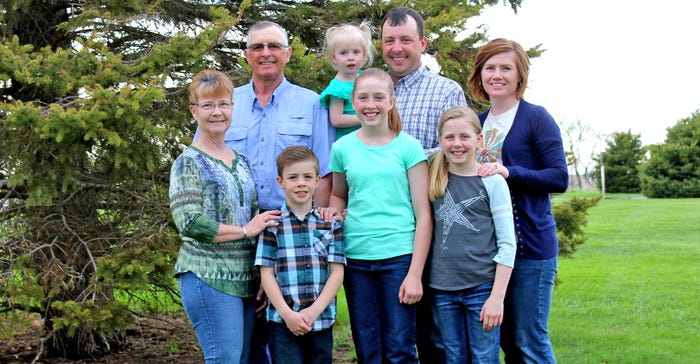May 16, 2019

CONSERVATION AWARD: Alan and Mickie Johnson (far left, front and back row) farm with their son Brian and his wife, Jamie, and their children Leo, 7, Ella, 12, Lila, 10, and Evelyn, 2 1/2. Jamie Johnson
Johnson Farms, of Frankfort, S.D., is the 2019 South Dakota Leopold Conservation Award winner.
Alan and Mickie Johnson, with their son Brian and his wife Jamie, farm 1,800 acres of cropland and 500 acres of grassland in Spink County. They will be presented with the $10,000 award and a crystal depicting Aldo Leopold at the South Dakota Cattlemen’s Association’s Annual Convention in December.
There will be a tour at their farm July 16.
Other finalists for the award this year were Bien Ranch, Veblen, S.D.; Blair Brothers Angus Ranch, Vale, S.D., and Hefner Ranch, Whitewood, S.D.
What they do
The Johnsons use a mix of old school practices and modern technology to manage their land — some of which has been in the family more than 100 years — so that it will be in better shape for future generations than it is now.
Alan adopted no-till farming practices in 1986. Back then, abandoning the plow, disk and cultivator was much against the norm. Despite what the neighbors thought, Alan saw that tilling a field to rid it of weeds was also depleting it of moisture. If rain was scarce by midsummer, crops suffered.
By coupling no-till practices with cover crops, the Johnsons have improved water infiltration and soil health.
The Johnsons also find that a diverse rotation of their corn, soybean, wheat, oat and barley crops and leaving crop residue in place minimizes agricultural runoff, naturally eases pest management and provides wildlife habitat. To further address soil erosion and salinity problems, the Johnsons enrolled land in the USDA Natural Resource Conservation Service’s Conservation Stewardship Program.
Realizing that different areas of each field have varying productivity, the Johnsons switched to a variable-rate fertilizer system in 2004. Applying the precise amount of nutrients on the soil saves time and natural resources and delivers a better return on investment. Since the switch, the Johnsons have won a yield contest held by the South Dakota Soybean Association.
Using cattle
The Johnsons raise a herd of Angus beef cattle. Whenever possible, the herd is allowed to graze on mature cover crops and corn stubble, which creates a cooperative relationship between the cattle and the land. The cover crops provide feed, and the cattle naturally fertilize the soil with their waste.
Grazing used to mean turning the cattle out to pasture for the summer and bringing them home in the fall. The Johnsons now rotationally graze their cattle and closely monitor grazing conditions and the timing of their calving season.
“The Johnsons are demonstrating how crops and cattle can work together to support their multiple-generation family farm while improving their natural resources and the bottom line,” says Steve Ollerich, South Dakota Cattlemen’s Association president. “We congratulate them as our 2019 Leopold Conservation Award recipients and applaud their conservation ethic.”
“The Johnson’s focus on conservation, while managing multiple enterprises on their family farm, is commendable and we congratulate them on receiving the 2019 South Dakota Conservation Award,” says Jim Faulstitch, South Dakota Grassland Coalition chairman. “We look forward to continuing to highlight their conservation story throughout the year.”
“Leopold Conservation Award recipients are at the forefront of a movement by America’s farmers and ranchers to simultaneously achieve economic and environmental success,” says Kevin McAleese, Sand County Foundation president and chief executive officer.
Award applicants were judged based on their demonstration of improved resource conditions, innovation, long-term commitment to stewardship, sustained economic viability, community and civic leadership, and multiple use benefits.
Sponsors helped
Sponsors of the Leopold Conservation Award in South Dakota include the South Dakota Cattlemen’s Association, South Dakota Grassland Coalition, First Dakota National Bank, South Dakota Department of Agriculture, South Dakota Department of Environment and Natural Resources — Discovery Center, South Dakota Department of Game, Fish and Parks, South Dakota Farm Bureau Federation, USDA Natural Resources Conservation Service, South Dakota State University College of Agriculture and Biological Sciences, Bad River Ranches, Belle Fourche River Watershed Partnership, Ducks Unlimited, Millborn Seeds, South Dakota Pheasants Forever, Daybreak Ranch, Audubon Dakota, South Dakota Soil Health Coalition, North Central SARE — Sustainable Agriculture Research and Education, Professional Alliance, South Dakota Association of Conservation Districts, The Nature Conservancy in South Dakota, Todd Mortenson family, U.S. Fish and Wildlife Service — Partners for Fish Wildlife, Wagner Land and Cattle Co., and McDonald’s.
Sand County Foundation presents the Leopold Conservation Award to private landowners in 13 states for extraordinary achievement in voluntary conservation.
For more information on the award, visit leopoldconservationaward.org.
Source: Sand County Foundation, which is solely responsible for the information provided and is wholly owned by the source. Informa Business Media and all its subsidiaries are not responsible for any of the content contained in this information asset.
You May Also Like




